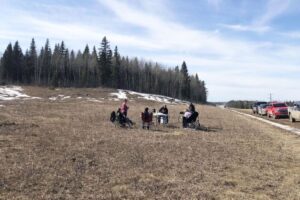If you haven’t yet noticed, there is activity down at the bush line by the new St. Joseph’s School. The Whitecourt Fire Department has started up their latest firesmart project and will be working out there, along with a contractor, for the next six weeks. The purpose of this project is to push the forest back from the school and clear up the debris that litters the forest floor, so that in the event of a wildland fire, Chief Brian Wynn and his crew would be able to reach hot spots.
“The school is a high priority risk, so our goal is to try and remove some of the forest and make it safer so that if there is a wildland fire, we can save the structure” explained Wynn. “I want to go as far as I can, but I’m only allowed to go so far on the east side because there is private property there and I can’t treat that. So, were going to be treating from the school right to the train tracks.”
As it currently sits, the forest area around the school is very thick, with downed trees, high vegetation and hangers (broken trees suspended in other trees), making it very dangerous. “You can’t even walk in there because there is so much dead and downed material” said Brian, which makes it impossible for wildland fire fighters to get in.
Along with clearing up the debris, the team will also be targeting certain species that are known for being matchsticks, including black spruce. “When those catch on fire, those are the ones that go up like a candle and those embers fly. It’s always the embers that start the next fires. There isn’t going to be a flame that touches this school, but millions of embers landing on the school, could take the school down. It’s the ember transfer that we trying to reduce” explained Chief.
Another part of the project will be thinning out the fuels, which includes spacing the trees and clearing branches under six feet. “By reducing the fuel, as soon as fire comes up to where we’ve treated with firesmart, we’re actually reducing the intensity to where it gets slow enough that we can actually stop it.”
The crew will be up to 10 people in size and there will be two or three mulchers working in the peak time as well. Residents do not have to worry about seeing smoke in the area from controlled burns as Chief assures there will be no fires. “We can’t have fires in here because it’s got a peat moss base. It’s too risky.” The reason for the winter timeline is because the ground is very boggy and without it being frozen, the equipment would never make it in.
The big promotion for firesmart this year is that firesmart begins at home. Chief Wynn asks residents to look around their own properties to see what they can do to be firesmart. “Remember, it’s not the flames coming in, it’s the embers.” Chief suggests looking into things that decrease your chances of embers starting a fire on your property, including tin roofs, proximity to fire wood and the right types of plants.
When Chief does home assessments for firesmart, he asks himself two questions; will it burn, or won’t it burn? “It’s like dumping a bunch of briquettes onto your property, with a 100km/h wind. Is it going to burn? You can make that judgement. When you’re using mulch around your structure, use rock. Don’t’ use dry bark because bark is fuel and rocks don’t burn. It’s as simple as that.”
Brian reminds residents that embers can travel up to 20/km and still be lit when they land. Given that fact, it is up to the community to make sure that properties are as firesmart as possible. “You are within the power to save your house or at least give it a fighting chance” said Wynn. “Everybody’s got to realize that in a wildland fire situation, we’re not coming to your house. I’ve got four fire trucks, so we’re going to be going to critical infrastructure. We will protect and sprinkler everything we can, but we are limited.”
Do your part by visiting www.firesmartcanada.ca and learning all you can about being firesmart.








More Stories
Big dreams lead a talented local youth to Nashville
It’s Youth Week in Whitecourt until Friday
Bowls for Hope, a growing tradition